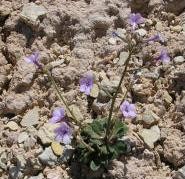Aliciella tenuis facts for kids
Quick facts for kids Aliciella tenuis |
|
|---|---|
 |
|
| Conservation status | |
| Scientific classification | |
| Genus: |
Aliciella
|
| Species: |
tenuis
|
Aliciella tenuis is a very rare flowering plant. It is also known as Gilia tenuis. People often call it the Mussentuchit gilia or Mussentuchit Creek gilia. This plant belongs to the phlox family.
It grows only in Utah, in the United States. Specifically, you can find it only in an area called the San Rafael Swell. When a plant or animal lives only in one specific place, it is called endemic.
Contents
What is the Mussentuchit Gilia?
The Mussentuchit gilia is a plant that lives for many years. It is a type of herb, which means it does not have a woody stem like a tree. This plant usually grows up to 15 centimeters (about 6 inches) tall.
Plant Features
- Its leaves grow near the bottom of the plant. These leaves are divided into several parts, like fingers.
- The whole plant is covered in tiny sticky hairs. These hairs often have sand stuck to them, which helps the plant in its sandy home.
- The flowers are a pretty pale blue color. They bloom during the spring and summer, usually from May through July.
Where Does it Live?
This special plant likes to grow in rocky and sandy places. You can find it on sandstone outcrops, which are places where sandstone rock sticks out of the ground. It also grows on talus slopes. These are slopes covered with broken rocks and debris.
Why is it Rare?
The Mussentuchit gilia is a very rare plant. It faces several challenges that make it hard for it to survive.
Threats to the Plant
- Energy Exploration: Activities like exploring for oil and gas can disturb the plant's habitat.
- Off-Road Vehicles: Vehicles driving off marked roads can crush plants and damage their growing areas.
- Mining: Digging for sand and gravel can destroy the places where the plant lives.
- Road Work: Maintaining roads can also disturb nearby plant populations.
- Illegal Collection: Some people might try to take these rare plants, which is against the law.
- Pesticides: Chemicals used to kill pests can harm the plants.
- Livestock: Animals like cows and sheep grazing can eat or step on the plants.
- New Plants: Some plants from other places can grow quickly and take over the space the gilia needs. These are called introduced species.
- Climate Change: Changes in weather patterns and temperatures can make it harder for the plant to grow and reproduce.


